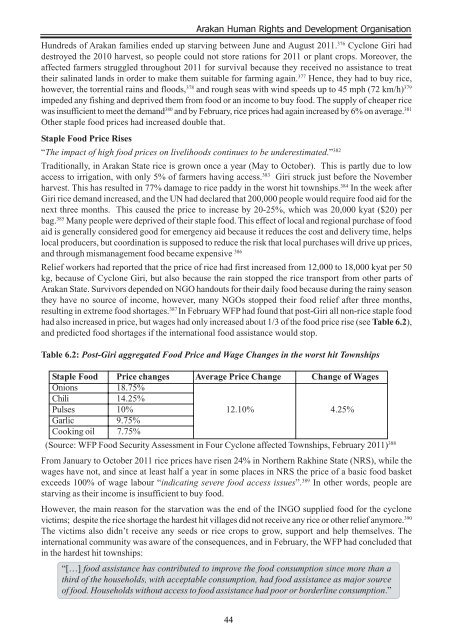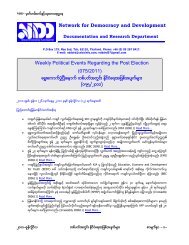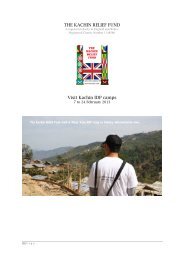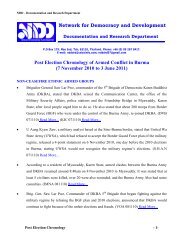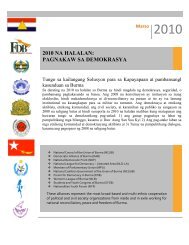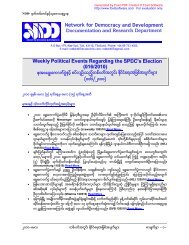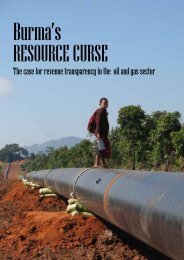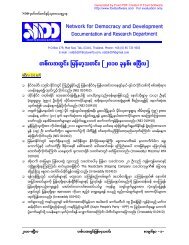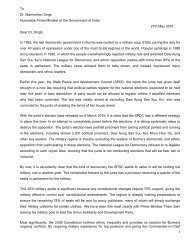Cyclone Giri - Two Years On - Burma Action Ireland
Cyclone Giri - Two Years On - Burma Action Ireland
Cyclone Giri - Two Years On - Burma Action Ireland
Create successful ePaper yourself
Turn your PDF publications into a flip-book with our unique Google optimized e-Paper software.
Arakan Human Rights and Development Organisation<br />
Hundreds of Arakan families ended up starving between June and August 2011. 376 <strong>Cyclone</strong> <strong>Giri</strong> had<br />
destroyed the 2010 harvest, so people could not store rations for 2011 or plant crops. Moreover, the<br />
affected farmers struggled throughout 2011 for survival because they received no assistance to treat<br />
their salinated lands in order to make them suitable for farming again. 377 Hence, they had to buy rice,<br />
however, the torrential rains and floods, 378 and rough seas with wind speeds up to 45 mph (72 km/h) 379<br />
impeded any fishing and deprived them from food or an income to buy food. The supply of cheaper rice<br />
was insufficient to meet the demand 380 and by February, rice prices had again increased by 6% on average. 381<br />
Other staple food prices had increased double that.<br />
Staple Food Price Rises<br />
“The impact of high food prices on livelihoods continues to be underestimated.” 382<br />
Traditionally, in Arakan State rice is grown once a year (May to October). This is partly due to low<br />
access to irrigation, with only 5% of farmers having access. 383 <strong>Giri</strong> struck just before the November<br />
harvest. This has resulted in 77% damage to rice paddy in the worst hit townships. 384 In the week after<br />
<strong>Giri</strong> rice demand increased, and the UN had declared that 200,000 people would require food aid for the<br />
next three months. This caused the price to increase by 20-25%, which was 20,000 kyat ($20) per<br />
bag. 385 Many people were deprived of their staple food. This effect of local and regional purchase of food<br />
aid is generally considered good for emergency aid because it reduces the cost and delivery time, helps<br />
local producers, but coordination is supposed to reduce the risk that local purchases will drive up prices,<br />
and through mismanagement food became expensive 386<br />
Relief workers had reported that the price of rice had first increased from 12,000 to 18,000 kyat per 50<br />
kg, because of <strong>Cyclone</strong> <strong>Giri</strong>, but also because the rain stopped the rice transport from other parts of<br />
Arakan State. Survivors depended on NGO handouts for their daily food because during the rainy season<br />
they have no source of income, however, many NGOs stopped their food relief after three months,<br />
resulting in extreme food shortages. 387 In February WFP had found that post-<strong>Giri</strong> all non-rice staple food<br />
had also increased in price, but wages had only increased about 1/3 of the food price rise (see Table 6.2),<br />
and predicted food shortages if the international food assistance would stop.<br />
Table 6.2: Post-<strong>Giri</strong> aggregated Food Price and Wage Changes in the worst hit Townships<br />
Staple Food Price changes Average Price Change Change of Wages<br />
<strong>On</strong>ions 18.75%<br />
Chili 14.25%<br />
Pulses 10% 12.10% 4.25%<br />
Garlic 9.75%<br />
Cooking oil 7.75%<br />
(Source: WFP Food Security Assessment in Four <strong>Cyclone</strong> affected Townships, February 2011) 388<br />
From January to October 2011 rice prices have risen 24% in Northern Rakhine State (NRS), while the<br />
wages have not, and since at least half a year in some places in NRS the price of a basic food basket<br />
exceeds 100% of wage labour “indicating severe food access issues”. 389 In other words, people are<br />
starving as their income is insufficient to buy food.<br />
However, the main reason for the starvation was the end of the INGO supplied food for the cyclone<br />
victims; despite the rice shortage the hardest hit villages did not receive any rice or other relief anymore. 390<br />
The victims also didn’t receive any seeds or rice crops to grow, support and help themselves. The<br />
international community was aware of the consequences, and in February, the WFP had concluded that<br />
in the hardest hit townships:<br />
“[…] food assistance has contributed to improve the food consumption since more than a<br />
third of the households, with acceptable consumption, had food assistance as major source<br />
of food. Households without access to food assistance had poor or borderline consumption.”<br />
44


